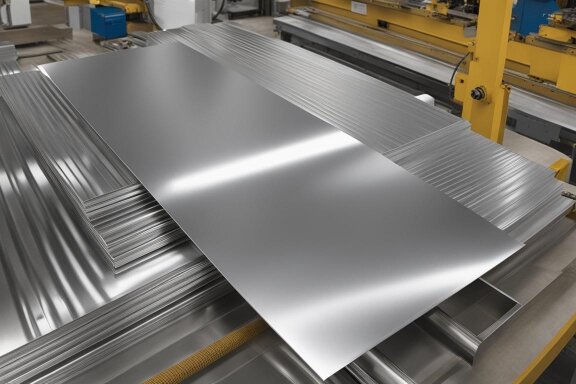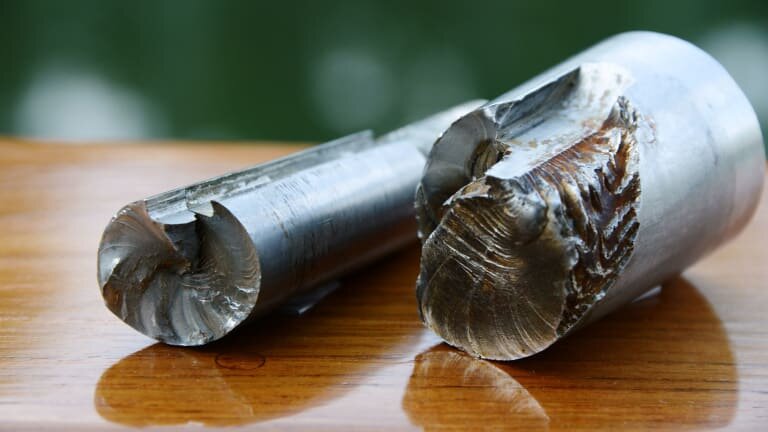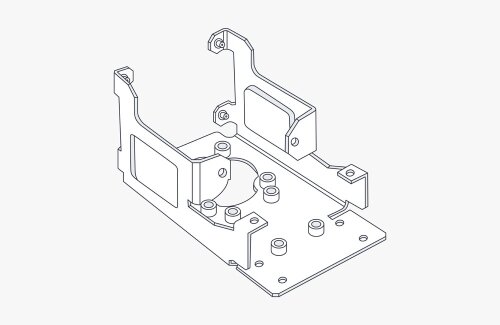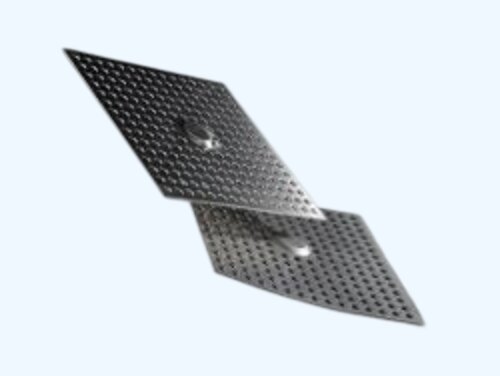We are often asked questions at Shengen about sheet metal fabrication. A question we often get asked is, “How to weld brass?” It may be challenging to weld brass, but this skill is essential for many applications. This blog post will guide you through the techniques and steps to mastering the art of welding brass.
You must use the correct flux, filler type, and TIG welding process to weld brass. You must also carefully control the temperature so the material does not overheat and become weak.
Intrigued? Stay tuned as we delve deeper into this topic. We created this guide for amateurs and professionals looking to improve their brass welding skills.
Understanding Brass
What is Brass?
Composition and Properties
Brass is an alloy. It is a mixture primarily of copper and zinc. The amount of zinc affects the alloy’s properties, varying from 10% to 40%. Brass has several notable properties, including:
- Machinability:Brass is easily machined, making it an ideal material for complex components.
- Resistance to Corrosion: Brass is a very corrosion-resistant metal due to the presence of copper.
- Aesthetic Appeal: The golden color of brass is popular in decorative applications.
Brass is composed of a variety of different materials. Understanding their composition and properties will help you determine the best way to weld them.
Brass Main Elements
What Elements affect brass welding?
Brass is primarily composed of copper and zinc. Lead can be added to brass for specific properties.
- Copper: Brass is malleable and corrosion-resistant due to its copper content. You must control its high melting point during welding.
- Zinc: Zinc is a metal that lowers melting points and increases hardness, but it can oxidize or evaporate during welding.
The elemental composition of your brass alloy will help you choose the best welding technique and filler material.
Brasses come in many different types.
Brass is available in several types, each with unique properties and uses.
- Alpha Brass: High copper content and low zinc content. Best for cold work.
- Beta Brass: This brass contains a higher zinc level and is ideal for hot work.
- Lead Brass: Lead-containing brass with improved machinability.
Each type of Brass has different welding requirements. Identifying the kind of Brass you use before starting a weld is essential.
Why weld brass?
Applications and Use Cases
Why bother with brass welding? Its versatility is the answer.
- Decorative Arts:Artists use brass to create sculptures, ornaments, and medals.
- Musical instruments:The alloy has excellent acoustic qualities, making it perfect for trumpets and trombones.
- Industrial Machinery:Brass is used widely in industrial settings due to its machinability and corrosion resistance.
Prepare for Brass Welding – Are you ready?
Safety is always first. Then comes the suitable materials and tools, and then comes preparing brass and choosing appropriate welding consumables.
Safety Measures
Personal Protective Equipment
Safety is the number one rule when it comes to welding. To protect yourself, you’ll need to wear the following PPE:
- Welding helmet: Protects the face and eyes against sparks and intense lights.
- Leather Gloves: These gloves protect your hands from heat, spatter, and other harmful substances.
- Safety Boots:Steel-toed safety boots protect against falling objects and electric shocks.
- Fire-resistant jacket: Protect against heat and spatter.
Workspace preparation
Your workspace must be well-ventilated, free of flammable material, and equipped with an extinguisher. You should have enough space to move around and set up your equipment.
Tool and Equipment Required
Choose a suitable welding machine.
We recommend TIG (Tungsten Inert Gas) for brass because of its precision and flexibility. You can use MIG (Metal Inert Gas welding) for some applications.
Additional Tools
Additional tools such as clamps, welding tables, and wire brushes will make your work easier.
Material Preparation
Brass Cleaning
Brass should be free of grease, dirt, or oxidation. Use acetone or degreaser with a wire brush to achieve this.
Pre-heating
Pre-heating the brass will help prevent it from cracking or warping. Depending on its thickness and type, you can pre-heat brass at temperatures between 200 and 300 degrees Fahrenheit.
Selecting Welding Brass Consumables
Types of filler metals
Silicon Bronze filler bars are popular in brass due to their excellent color matching and flow characteristics. Aluminum bronze and pure copper are also options.
Matching base and filler metals
Ensuring the filler metal is compatible with the base metal is crucial. If welding with leaded brass, you will need a filler metal with lead content matching your base metal.
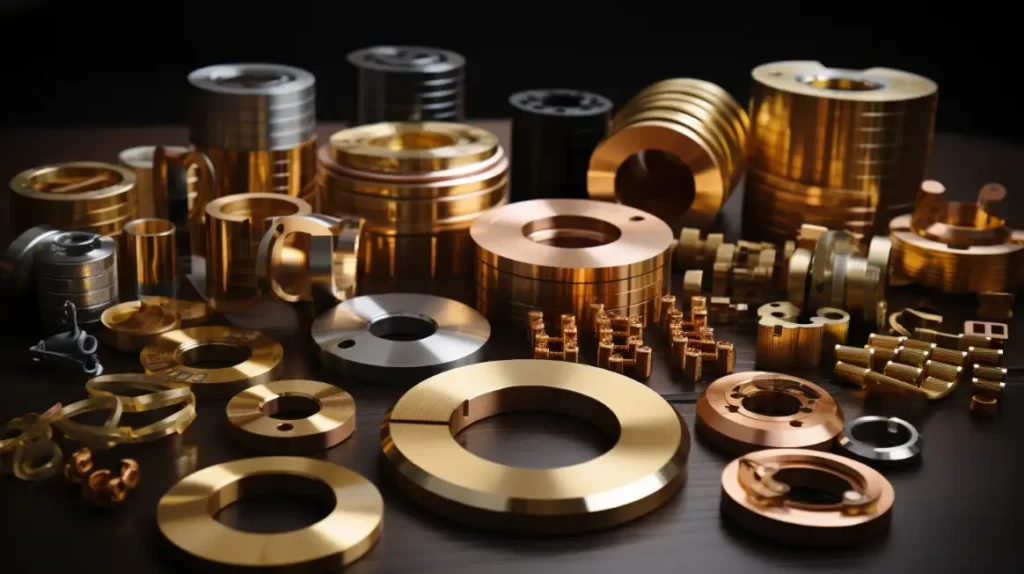
Common Challenges of Brass Welding – How to overcome them?
Three common challenges during brass welding are porosity, cracks, and melting. Each problem requires different solutions, ranging from material preparation to welding techniques.
Porosity is a pernicious problem.
What causes porosity?
Trapped gas in a weld can create voids and pores, weakening the overall structure. Often, contamination of the material’s surface, such as dirt, oil, or oxide layers, is to blame.
How to avoid Porosity
- Clean Brass:Use a degreaser, acetone, and a wire brush to remove contaminants.
- Control Shielding gas Flow: Set your shielding gases correctly to avoid air contamination in the weld pools.
Cracks: Unwelcome guests
What causes cracks in concrete?
Stresses induced during the cooling phase usually cause cracking. Cracking is more common in brass alloys that contain a high zinc content.
How to prevent cracks?
- Preheating: By preheating brass, you can reduce the chances of cracking.
- Heat Treatment After Weld: A controlled cooling or annealing is also helpful to minimize cracking.
Melting: A Fine Balance
What causes melting issues?
Brass is a metal with a lower melting temperature than steel. This makes it easier to melt the workpiece accidentally.
How can you control melting?
- Welding speed: A consistent welding speed is essential for a uniform bead. Inconsistency may lead to porosity, weak bonds, and undercut defects.
- Lower Amperage: A lower current setting will help to control heat input and reduce the risk of melting.
What is the best welding process for brass?
You must choose a welding process compatible with the project requirements, material specifications, and desired results. Each method, from TIG and MIG to specialized techniques such as electron beam welding, offers pros.
Brass TIG Welding
TIG Welding Brass Process Overview
TIG welding (Tungsten-Inert Gas) uses a tungsten rod to create the arc and a filler rod for adding material. A shielding gas (usually argon) protects the welding area from contamination.
Benefits:
- Precision:TIG is an excellent tool for fine work.
- Flexibility: Flexible for different brass types and thicknesses.
- High-Quality Welds: Know for producing solid and clean welds.
Limitations:
- A Slower Process: TIG welding is time-consuming.
- Skill level: This skill requires a high level of expertise.
MIG Welding Brass
Process Overview
In Metal Inert Gas (MIG) welding, a wire-feed system feeds filler metals into a pool shielded with inert gases.
Benefits:
- Speed: MIG is faster than TIG.
- Ease Of Use:It is suitable for both beginners and professionals.
Limitations:
- Lower precision: not ideal for intricate work
- Spatter: Produces more spatter and requires post-weld cleaning.
Flame Welding Brass
Flame welding uses an open flame, often from a propane torch, to melt the brass and filler materials. This is the most basic form of welding, and it is used for less-critical applications when precision is not a significant concern.
Benefits:
- Accessibility: Flame welding equipment can be easily obtained and is inexpensive.
- Ease Of Use:It is a simple technique that does not require extensive training.
Limitations:
- Less control: This method is less controlled than TIG or MIG.
- Uneven Results: The outcome of a test can only be consistent if the skill is sufficient.
Oxy-Acetylene Welding Brass
Oxy-acetylene welding uses oxygen and acetylene gas to create a hot flame that can melt brass. This method is more versatile than flame welding and allows for better temperature control.
Benefits:
- High-Temperature: This mixture produces a hotter flame than propane and offers better control.
- Versatility: Can be used with different materials and thicknesses.
Limitations:
- Safety Concerns: Handling oxygen and acetylene cylinders requires strict safety measures.
- Cost: Gas can be more costly than other methods.
Electron Beam Brass Welding
Electron Beam Welding uses a stream of high-speed electrons to heat the workpiece. This highly specialized technique is used primarily by aerospace, automotive, and other high-tech sectors.
Benefits:
- Extreme precision: Provides exceptionally high levels of accuracy.
- Deep Weld penetration: Capable of joining thick materials effectively.
Limitations:
- High costs: The equipment is expensive and requires special operators.
- Limited Accessibility:Not available for small or medium-sized operations.
Brazing Techniques for Brass
The brazing process involves melting and flowing filler metal through the joint. Filler metals have a lower melting temperature than base metals, which makes them easier to control and manipulate during the process.
Silver Brazing
Silver brazing is a method of joining metals using a filler alloy based on silver. The filler has a high level of silver, which offers several advantages over other brazing techniques.
Benefits:
- Strength:Creates bonds that are very strong, often stronger than base metals.
- High Resistance to Corrosion: This material is highly corrosion-resistant and ideal for long-term use.
Limitations:
- Cost: Silver is a costly material, which drives up the price of the filler.
- Skill Required:Requires clean working conditions and proper fluxing to prevent contamination.
Bronze Brazing
Bronze brazing uses a bronze alloy as a filler. It is a popular method due to its ease of use and economics.
Benefits and Limitations
Benefits:
- Affordability: Generally cheaper than silver brazing
- Ease Of Use: More fussy about the cleanliness of base metals.
Limitations:
- Strength: Silver brazing is stronger.
- Corrosion: More susceptible over time to corrosion.
Soldering
Why and when should you choose Soldering?
Soldering and brazing are similar, but temperatures are lower, often below 450degC. People often use this method for electrical applications or when they don’t need high-strength joints.
Benefits:
- Low heat: Reduces heat distortion.
- Ease Of Use:It is easy to use and learn.
Limitations:
- Low strength: not suitable for high-pressure or load-bearing applications.
How should you weld brass joints?
By understanding the types of brass welding joints and the considerations that go with them, you can make better decisions to improve the quality of your product.
Welding joints in Brass Welding
Butt Joints
After aligning their edges, you weld the two pieces of brass together. It is the simplest type of joint, but it may need reinforcement to increase strength.
Considerations
- Alignment: A precise alignment is essential for the integrity of the joint.
- Reinforcement: Additional support may be required if the joint is to carry loads.
Lap Joints
When a piece of brass is lapped over another, the overlapped areas are welded.
Considerations
- Surface contact: An increased surface area increases joint strength.
- Material thickness: It is best when materials are similar in thickness.
T-Joints
You form a T-joint when you weld one piece of brass at 90 degrees to the edge of another part.
Considerations
- Accessibility: Both joint sides should be accessible to allow practical welding.
- Strength: The choice of filler material can have a significant impact on the power of the joint.
Corner Joints
You form corner joints by placing two pieces of brass in a corner, typically at a 90-degree angle.
Considerations
- Angle: Alignment must be precise to maximize strength.
- Material Thinness: Take note of the thickness of the material, as it will affect the welding technique used.
Edge Joints
You create edge joints by welding together the edges of adjacent brass pieces.
Considerations
- Gap: Maintain a minimum gap between the pieces to ensure a strong joint.
- Pool: Carefully control the collection to avoid spillage or weakening.
What is a high-quality brass weld?
You can learn a lot from the characteristics of a weld in brass. These features will help ensure that your end product meets the highest durability, appearance, and performance standards.
Consistency
What is Consistency?
The consistency of a weld is the size and spacing of the bead.
Why Does it Matter?
- Predictable strength: It is more likely that a consistent weld will have a uniform distribution of mechanical stresses.
- Aesthetics: Uniform welding is generally more pleasing to the eye.
No Undercutting
What is undercutting?
Undercutting occurs when the weld groove edge melts, reducing material thickness.
Why Does it Matter?
- Reduced strength: The joint is more susceptible to cracking when undercut.
- Material Wastage:In extreme cases, this could lead to material waste and wasted time.
Minimal Spatter
What is Spatter?
Spatter is the term used to describe the tiny droplets of molten metal scattered about the welding area.
Why Does it Matter?
- Cleanliness:A minimal spatter indicates that the work environment is cleaner and requires less cleaning after welding.
- Material Efficiency: Less waste material means less spatter.
Absence of Porosity
What is Porosity?
The presence of small holes or voids in the weld is called porosity. This is often due to trapped gas.
Why Does it Matter?
- Strength:Porosity is a factor that can reduce the mechanical strength of a weld.
- Appearance: Visible pores are unappealing and can indicate quality problems.
Proper Penetration
What is proper penetration?
The penetration depth is the amount of the weld metal penetrating the base metal.
Why Does it Matter?
- Joint Strength:Proper penetration will ensure the joint is as strong as possible.
- Material Efficiency: You often need less filler material to achieve proper penetration.
How to Setup Properly for a Brass Weld
How to Set Up the Welding Machine
Voltage and Current Settings
What steps should you take?
Consult the user’s manual of your machine to determine the appropriate voltage and current for brass welding. Adjust the settings based on your welding application and the thickness of the brass.
Why is it important?
- Optimal Quality:Inappropriate voltage and current can result in weak, uneven, or unattractive welding.
- Energy Efficient: The correct machine parameters can be important for energy costs and resource conservation.
Gas Selection and Shielding
What steps should you take?
Shielding gas is often the first line of defense in fighting impurities and oxidation. A mixture of Argon and Co2 is a good shielding gas for brass. Make sure your flow rates follow the guidelines.
Why is it important?
- Weld integrity: Using suitable shielding gases will protect molten brass against oxidation and other impurities. This is critical for long-lasting welding.
- Visual Quality: Shielding gas can affect the smoothness of the weld and the color, which may be significant depending on your application.
Workpiece Positioning
Clamping
What steps should you take?
Make sure to clamp the workpiece on your table or welding fixture securely. Use clamps specifically designed to handle high temperatures and resist electrical conductivity.
Why is it important?
- Stability: A securely clamped workpiece remains stationary throughout the welding process. This ensures an even weld.
- Safety:Proper clamping reduces the risk of workpieces moving, causing dangerous accidents.
Alignment
What steps should you take?
Double-check your alignment before you start the first arc. Align your workpieces precisely using measuring tools such as squares or calipers.
Why is it important?
- Structural integrity: A precise alignment is necessary to create strong joints that stand the test of time.
- Aesthetic Qualities: Misaligned pieces can lead to uneven or warped welding, affecting the overall look and feel of the project.
Trial Runs
Test Welds
What steps should you take?
Perform test welds on scrap materials similar to the actual workpiece. You can then see how your machine’s settings, consumables, and welding techniques interact.
Why is it important?
- Quality control:Test welds are a safe environment for evaluating your setup’s effectiveness. They can help to minimize potential errors or flaws in advance.
- Cost Efficiency: Fixing issues in the testing phase can save time and money.
Adjustments
What steps should you take?
Make any adjustments to your machine settings or technique after evaluating the test welds. Adjusting the voltage or changing the gas flow can lead to significant improvements.
Why is it important?
- Precision: Adjusting your setup can achieve more accurate and consistent welding.
- Confidence: You can approach actual welding more confidently with a refined process.
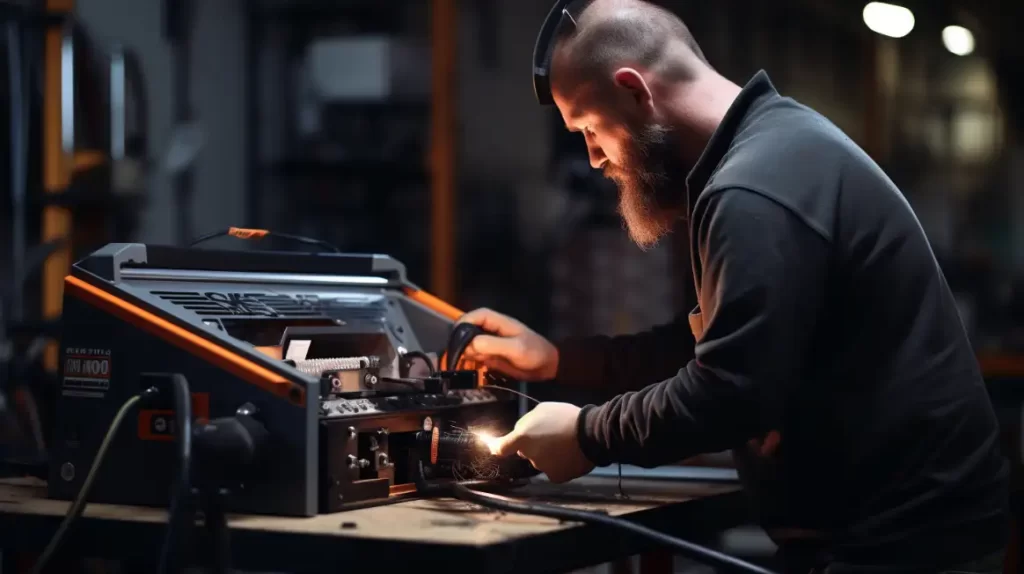
How do you master the art of executing a brass weld?
To achieve a perfect brass weld, you must master three key aspects: starting the arc, controlling heat input, and controlling the weld pool.
Start the Arc
What techniques should you employ?
Select an arc striking technique that suits your welding method and the type of brass you are using. If you use scratch start or lift start to create the arc, strike it smoothly. This will minimize contamination.
Why is it important?
- Welding Quality: A well-struck, clean arc is a good starting point for a structurally sound and reliable weld.
- Material Preservation: A proper arc start minimizes waste and spatter, conserving brass.
Manage Heat Input
How to avoid Brass Melting or Burnthrough?
Brass is a metal with a lower melting temperature than steel. Therefore, managing the heat input becomes crucial. It is essential to keep a good balance. Too much heat can cause burning and melting, while insufficient could lead to incomplete welding. In this case, pulsed current settings may be helpful.
Why is it important?
- Structural integrity: Inappropriate temperatures can cause the metal to weaken, which will affect the durability and reliability of the weld.
- Material Efficiency:By managing heat effectively, you can minimize waste caused by excessive melting or burning.
Weld pool Control
Add Filler Materials and Techniques to Pool Control
To control the pool, carefully add filler material while maintaining an optimal distance and angle with your torch. For maximum pool control, use techniques such as pushing or dragging depending on the type of weld and brass material.
Why is it important?
- Consistency: A uniform and aesthetically pleasing bead is only possible with a consistent weld pool.
- Material Binding: The correct addition of filler materials ensures that a robust and well-bonded weld will withstand stress and usage over time.
How to Explain Post-Welding Procedures in Brass Welding
Three steps are crucial in the post-welding procedure for brass: cooling the weld down, cleaning the surface of the weld, and checking the quality.
Cooling down
Natural Cooling vs Forced Cooling: Which one to choose?
You have two options for cooling the weld: forced or natural. The natural cooling method makes the piece extraordinary until it reaches room temperature. Causing cooling may include techniques such as using compressed air and water sprays.
Why is it important?
- Material Integrity:Choosing the incorrect cooling method can lead to thermal stress and even cracks.
- Time efficiency: Quick cooling can be necessary to meet production deadlines. However, it is essential to do so cautiously to avoid material damage.
Clean the Weld
How do you remove oxidation and residue?
It’s time to clean the area after the weld is sufficiently cooled. To remove oxidation and spatter from the weld, use a wire scrubber for mechanical cleaning or a chemical cleaner for chemical cleaning.
Why is it important?
- Longevity: Cleaning up residues and oxidation will help to prevent corrosion, increasing the life of the weld.
- Visual Inspection: A clean weld makes it easier to detect defects or inconsistencies.
Inspection of the Weld
What are the methods of quality control?
The quality inspection method can vary from simple visual inspections to more complex procedures such as X-ray or ultrasonic tests, depending on how critical the weld is.
Why is it important?
- Safety: Ensuring that the weld conforms to all safety and quality standards for long-term performance is essential.
- Client satisfaction: Achieving quality standards is more than just a benchmark for your company. It’s a promise to clients.
How to troubleshoot brass welding issues
Common Welding problems
What is causing your weld to be problematic? What’s bothering your weld?
Porosity, cracks, and foreign material are some common defects. Contaminated filler or base material often causes porosity. Thermal stresses or the use of incorrect filler materials can cause cracks.
Why is it important?
- Structural stability:These flaws may weaken a weld and make it more prone to failure.
- Reputation: Poor welds can impact customer trust and the importance of your brand.
Solution and Fixes
What can be done to restore the welds?
Check for contaminants, and use clean, dry materials. You can repair cracks by changing the filler or welding parameters. In some cases, it may be necessary to reweld the section after removing any defective areas.
Why is it important?
- Cost Efficiency: Early problem-solving can save time and money.
- Quality Assurance: Taking corrective actions will ensure that the final product meets the desired standards.
Can You Weld Brass to Steel?
What is the difference between brazing and soldering?
It is possible to braze or solder brass onto steel. Brazing uses a filler metal with a melting temperature above 840°F but below the melting points of the base metals. Soldering is performed at lower temperatures and is generally less durable than brazing.
Why is it important?
- Material compatibility: Knowing whether to braze or solder can distinguish between success and failure when joining dissimilar materials.
- Functional requirements: The chosen method should align itself with the mechanical and environmental needs of the final item.
Gas Welding Brass: Can you do it?
Gas welding, specifically oxyacetylene, is available for brass. A neutral or slightly reducing flame at lower temperatures is essential to prevent overheating.
Why is it important?
- Versatility: Understanding multiple welding techniques enhances your fabrication possibilities.
- Skill development: By mastering various styles, you become a better welder capable of undertaking various projects.
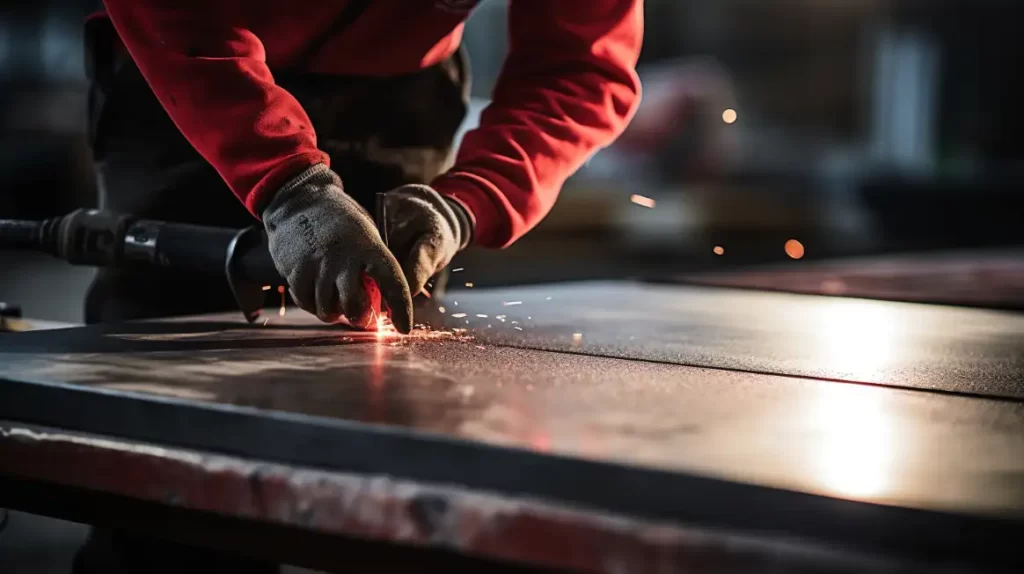
How do you weld brass with other metals?
Welding Brass With Other Metals
What are the best practices for welding brass with other metals?
Consider TIG or brazing with a filler metal to join brass to metals such as steel, aluminum, or copper. Test the joint design on small samples before implementing it in your final project. Pre-cleaning metal surfaces with flux and pre-spraying them can also make a massive difference to the quality of the joint.
Why is it important?
- Joint Strength: The compatibility between the materials directly impacts the mechanical properties.
- Cost savings: Choosing the wrong metals and welding techniques can result in costly failures in time and material.
What are the challenges and considerations when welding brass with other metals?
Brass and other metals have different melting points, coefficients of expansion, and thermal conductivity. These differences can pose challenges. If you are welding brass with steel, for example, the difference in melting point is an important consideration.
Why is it important?
- Complexity: Different metals have different properties that can make welding more difficult. This may require specialized equipment or advanced techniques.
- Quality Assurance: By understanding these challenges, you can take proactive measures to improve the quality and durability of your joints.
What are the latest technologies and techniques that can transform brass welding?
Welding Automated for Brass
What makes automated welding a game-changer for brass?
Automated welds are highly repeatable, which reduces the margin for error. The computerized welding process operates faster and can run continuously. This allows for higher production rates. The majority of automated systems use TIG and MIG methods. These are ideal for brass because they offer precision and control.
Why is it important?
- Efficiency:Automated systems are much more efficient than manual welding and can maximize output.
- Quality: Automated systems provide a consistent weld, which is essential for applications requiring high standards.
Using Software for Precision Welding
How does software improve the quality of brass welding?
Software solutions that are advanced can provide welding guidance with an unprecedented level of accuracy. The software can help you achieve the best welds possible.
Why is it important?
- Precision:Software allows micro-level adjustments, which are difficult to achieve manually.
- Data Analyses: By collecting and analyzing data, you can identify areas that need improvement. This will lead to a better product and increase efficiency.
What can real-world case studies tell us about brass welding?
Brass Welding Examples Specific to Industry
What are the benefits of brass welding in the automotive industry?
For their mechanical and corrosion-resistant properties, brass components are used frequently in automotive systems. Recently, we completed a project that involved the fabrication of brass fuel line connectors. We selected TIG for its precision and exceptional results.
Brass Welding in Construction: What is its role?
Brass is used widely in the construction industry for fixtures and fittings. We have experience in welding brass pipes, including for luxury home installations. People use brazing techniques to create solid and leak-proof joints.
Brass Welding in Artwork: What is its role?
Artists use brass for its color, malleability, and durability. A brass installation with intricately welded elements was a project we worked on together. The project was creative, so attention to detail and MIG were vital.
Lessons Learned
- Material compatibility matters: Our experience in different industries has reminded us of the importance of choosing the correct welding technique and filler material for each application.
- Quality Assurance Is Key: Quality assurance is essential if you’re looking for a high-pressure fuel line for a car or a water hose in your home.
- Flexibility Is Crucial: The requirements of an automotive project will be completely different than those for an art installation. Our ability to adapt our techniques and approaches has helped us meet clients’ diverse needs.

What must you know about legal and regulatory compliance in brass welding?
Safety Standards
How do we comply with OSHA, ANSI, and other relevant bodies?
Welding projects are always a priority for us. We strictly adhere to the Occupational Safety and Health Administration standards (OSHA), which cover a wide range of safety measures, including workspace ventilation and Personal Protective Equipment. We also follow American National Standards Institute guidelines, especially for eye and facial protection when welding.
Why is Safety Compliance Important to You?
- Protecting Workers: Ensuring workers’ safety is more than a legal requirement. It’s a moral duty.
- Liability management: Compliance is crucial in avoiding potential legal consequences and damages for the business.
Environmental Considerations
What are our practices for waste disposal and emissions?
We are very aware of the environmental responsibility we have at Shengen. Our waste disposal methods comply with local and global regulations. We ensure that hazardous wastes, like welding fumes or slags, are appropriately collected and disposed of. We have fume extraction systems in our facility to reduce emissions.
Why is environmental compliance substantial?
- Sustainability: Responsible waste management is essential for a sustainable tomorrow.
- Regulatory Compliance: Failure to comply with environmental standards may result in harsh penalties and tarnish a company’s image.
Conclusion
Industries ranging from construction and automotive to art use brass welding. Understanding the properties and methods of welding brass will help you create high-quality products. But knowledge and skill alone aren’t enough. Safety measures, environmental concerns, and regulatory compliance are all important.
Do you need a reliable sheet metal parts manufacturer? Shengen is the place to go. We specialize in sheet metal laser cutting, bending, surface finish, and sheet metal welding. We place a high priority on establishing trust, maintaining standards of quality, providing competitive prices, and guaranteeing timely delivery. Reach out to Shengen Today and seek help from professionals!
More resources:
OSHA Welding Guidelines – Source: OSHA
ANSI Standards – Source: ANSI
Environmental Protection Agency – Waste Management – Source: EPA
American Welding Society – Welding Brass – Source: AWS
Hey, I'm Kevin Lee

For the past 10 years, I’ve been immersed in various forms of sheet metal fabrication, sharing cool insights here from my experiences across diverse workshops.
Get in touch

Kevin Lee
I have over ten years of professional experience in sheet metal fabrication, specializing in laser cutting, bending, welding, and surface treatment techniques. As the Technical Director at Shengen, I am committed to solving complex manufacturing challenges and driving innovation and quality in each project.

